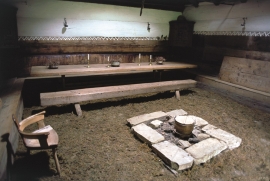Published: 27.07.2015 | Author: Nils Georg Brekke
The Ådland house is one of the biggest medieval houses still existing in West Norway. It is constructed from unusually large, hard fir wood, beautifully oval-cut. One story links the cottage to the Gildeskålbakken at Orninggård (Lower Ådland); thus indicating that the cottage has been the medieval banqueting hall. The building has been dated back to the 13-1400s by carbon dating.
The building was taken over by the Society for the Preservation of Ancient Monuments in Norway in 1873, and is one of the first farmhouses in this country that was preserved. It was moved to the Sunnhordland collection in Leirvik in 1934 and formally taken over by Sunnhordland Folk Museum in1980.
Bishop Neumann mentions the building as a smokehouse in 1828 when visiting Stord. At the museum it has been reconstructed with the smoke vent in the roof. Marks on the wall may indicate that it once was equipped with a smoke-stove. Otherwise the interior has been returned to its medieval state with earthen benches, a long table, earthen floor, and decoration on the walls (kroting). The box for the smoke vent was probably shifted when the building was moved. The new box has inscriptions and the year 1804 from the old one.
- Lexow, J.H. (1969) Ådlandsstova på Stord. I: Foreningen til norske fortidsminnesmerkers bevaring, Årbok. Oslo, Foreningen, s. 164-167.
- Skre, I. (1962) Ådlandstova. I: Sunnhordland Årbok. Stord, Sunnhordland museum, s. 78-82.




